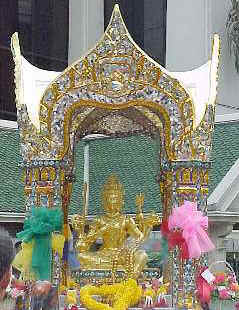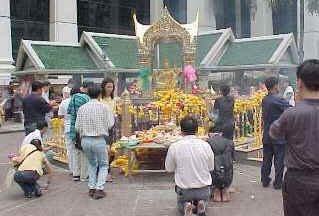

Erawan Shrine
 Erawan
Shrine (or San Phra Phrom - in Thai) was created as a spirit house
connected to the Erawan Hotel, which has now make way for the Grand Hyatt Erawan
Hotel. The force of the typical Thai spirit house did not seem effective during
the building of the hotel, so spiritual persons advised that it should be
replaced with the four-headed image of Brahma, a Hindu god or Phra Phrom
in Thai. There have been no further hitches, since then and the shrine has
become famous for bring good fortune. The name Erawan comes from Brahma's
thirty-three headed elephant. The shrine is greatly revered by people.
Erawan
Shrine (or San Phra Phrom - in Thai) was created as a spirit house
connected to the Erawan Hotel, which has now make way for the Grand Hyatt Erawan
Hotel. The force of the typical Thai spirit house did not seem effective during
the building of the hotel, so spiritual persons advised that it should be
replaced with the four-headed image of Brahma, a Hindu god or Phra Phrom
in Thai. There have been no further hitches, since then and the shrine has
become famous for bring good fortune. The name Erawan comes from Brahma's
thirty-three headed elephant. The shrine is greatly revered by people.
Laced flowers and small wooden elephants. Thai dancing performances are always offered to the statue by grateful devotees.
Though not a Wat, the shrine is an important Thai religious edifice. Buddhism is a religion not concerned with the existence or non-existence of God, or gods, or spirits. The believe in supernatural elements, however, is part of the common religious life of the Thai people. They worship heavenly beings in various forms, and for fairly earthly wishes, such as money or fertility.
It is a small, simple, open-air sanctuary containing a four-headed bronze Brahma sculpture thatís highly revered by Buddhists worldwide. Thailandís close ties with Hindu deities and animist traditions are blatantly demonstrated and abundantly clear at the famous Erawan Shrine. Originally built to ward off a string of construction accidents during the construction of the Erawan Grand Hyatt, this Brahma shrine is a favorite with those seeking reward or success in this life. The modest little shrine has become a Buddhist Mecca. Because of miracles attributed to the goddess at this site, Buddhists from around the world come to make offerings and requests, usually in matters of love or in hopes of winning the lottery.
The shrine is one of the best places to see traditional religious dances.
While many worshipping Thai just knee down and pray, some also hire the
musicians and dancers available on site - in order to give their requests more
weight. For a tourist, this offers  the
opportunity to see authentic traditional Thai dance and hear authentic
traditional Thai music played on traditional instruments - not tainted by what
tourism managers believe as being appealing to foreign visitors, and it is free
of charge.
the
opportunity to see authentic traditional Thai dance and hear authentic
traditional Thai music played on traditional instruments - not tainted by what
tourism managers believe as being appealing to foreign visitors, and it is free
of charge.
Even though the site of the Erawan Shrine is a corner heavily polluted by Bangkok road traffic, it's still the smell of incense sticks that predominates the air, indeed they are burned by the hundreds.
Another common practice seen at the Erawan Shrine is the offering of flower garlands and small wooden elephants (symbols of luck) both of which are sold by street vendors outside the shrine. Visitors will notice that as Thais pass by the shrine (either in their car, public bus or even walking), will perform a Wai towards the location of the shrine.
It's amazing to see how undisturbed the traditional
activities go on in spite of the proximity to modern day city life.
The premises is open 24 hours. Admission is free. Located at the
corner of Ratchadamri and Ploenchit Road across from Gaysorn Plaza.
Copyright © 2000 - 2002 HelloSiam.com All rights reserved.